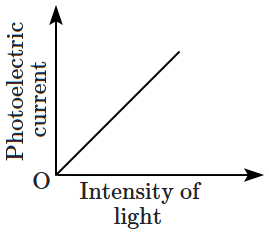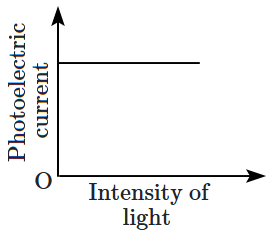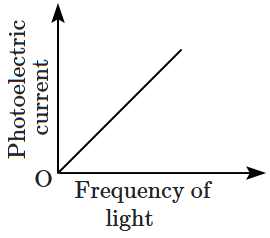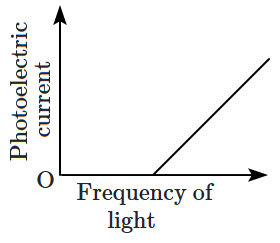The number of photo-electrons emitted per second from a metal surface increases when:
| 1. | The energy of incident photons increases. | 2. | The frequency of incident light increases. |
| 3. | The wavelength of the incident light increases. | 4. | The intensity of the incident light increases. |
| 1. |  |
2. |  |
| 3. |  |
4. |  |
The value of stopping potential in the following diagram is given by:

| 1. | \(-4\) V | 2. | \(-3\) V |
| 3. | \(-2\) V | 4. | \(-1\) V |
A point source of light is used in an experiment on photoelectric effects. Which of the following curves best represents the variation of photocurrent \((i)\) with distance \((d)\) of the source from the emitter?

| 1. | \(a\) | 2. | \(b\) |
| 3. | \(c\) | 4. | \(d\) |
The figure shows the variation in photoelectric current \((i)\) with voltage \((V)\) between the electrodes in a photocell for two different radiations. If \(I_a\) and \(I_b\) are the intensities of the incident radiation and \(\nu_a\) and \(\nu_b\) their respective frequencies, then:

| 1. | \(I_a>I_b,~ \nu_b<\nu_a\) | 2. | \(I_a<I_b, ~\nu_b>\nu_a\) |
| 3. | \(I_a>I_b,~ \nu_b=\nu_a\) | 4. | \(I_a<I_b, ~\nu_b<\nu_a\) |
| \(\mathrm{(A)}\) |  |
\(\mathrm{(B)}\) |  |
| \(\mathrm{(C)}\) |  |
\(\mathrm{(D)}\) |  |
2. \(\mathrm{(B)}\) and \(\mathrm{(D)}\)
3. \(\mathrm{(A)}\) only
4. \(\mathrm{(A)}\) and \(\mathrm{(C)}\)
| 1. | \(N\) and \(2T\) | 2. | \(2N\) and \(T\) |
| 3. | \(2N\) and \(2T\) | 4. | \(N\) and \(T\) |
The stopping potential for photoelectrons:
| 1. | does not depend on the frequency of the incident light. |
| 2. | does not depend upon the nature of the cathode material. |
| 3. | depends on both the frequency of the incident light and the nature of the cathode material. |
| 4. | depends upon the intensity of the incident light. |
The stopping potential as a function of the frequency of the incident radiation is plotted for two different photoelectric surfaces \(A\) and \(B\). The graphs demonstrate that \(A\)'s work function is:

| 1. | Greater than that of \(B\). | 2. | Smaller than that of \(B\). |
| 3. | Equal to that of \(B\). | 4. | No inference can be drawn about their work functions from the given graphs. |
The stopping potential \((V_{0})\) versus frequency \((\nu_{0})\) plot of a substance is shown in the figure. What will be the threshold wavelength?

| 1. | \(5 \times 10^{14}~ \text{m}\) | 2. | \(6000~\mathring{A}\) |
| 3. | \(5000~\mathring{A}\) | 4. | Cannot be estimated from given data |






